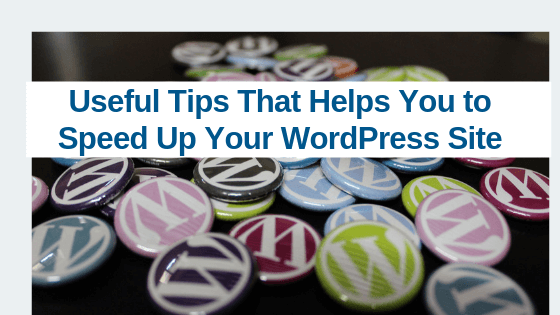Useful Tips That Helps You to Speed Up Your WordPress Site
Speed plays a very decisive role in the world of internet. People require fast internet browsing speed, fast upload/download speed, the fast opening of websites, and the fast accumulation of information. The importance of speed can be found out by the certain algorithms of Google, who takes speed into consideration while positioning websites. So, all the website administrators, consider this as a BIG WARNING, but if your website loads too sluggishly, then you are most likely to see your website going down in the Google rankings, which will subsequently mean that the number of visitors on your website would also decrease and forget about making profits because then, the main objective would be to earn for the survival.

This is not the story of a movie, but it can actually happen if you don’t pay attention to the speed of your website. This was the problem, and now, you must be desperate to get the solution on how to speed up your website. So, here are a few points that can help speed up your website, so that you don’t have to lose your position from the first page to 5th or 8th page. Most sites are made in WordPress today, so I’m considering your site to be in WordPress only. There is not much difference in the loading time of WordPress sites to other website builders.
Optimize images on your website
There are three main things to concentrate upon when considering images, which are; Format, src attribute, and size of the images.
Image size
Images that are oversized take a whole lot of time to load, therefore keep the images to an optimum level, so that they can load quickly. You can take help of certain image editing tools to adjust the width and height of the images. Some people upload the image and then, go into the HTML editor and resize the width, which is the wrong method. It won’t help, so resize the images in an image editing tool. Secondly, keep the color depth at a minimal level where you are satisfied as well. Thirdly, remove any comments on the image.
Image format
I would recommend JPEG format, as it is light and works JPEG is your finest alternative. The PNG format is also fine, but old browsers might not support PNG files properly. For small and simple graphics and animated images, GIF format can be used. Avoid BMP and TIFF format image file.
Src attribute
After choosing the size and format of the images, check the coding part. Don’t keep empty src codes in the images. In HTML, image code looks like<img src=””>. In case, there is no source in the quotation marks, your browser will ask for a request to the page directory or to the main page itself. This can get needless traffic to your servers and make user data corruption as well.
Trim HTML, CSS and JavaScript
In the coding area, delete the white spaces where they are not required. They are used to make codes more readable, but if you want to speed up your website, you have to delete these white spaces. You only require codes to execute without errors, which will happen. You can add plugins like W3 Total Cache and WP Minify to manage the codes at runtime.
Add the best Caching Plugin
If static images, JavaScript and CSS of your website change infrequently, then browser-side caching will make your website succinct, as it relies upon the web application techniques you follow. Caching will engage all the storing parts of your site so that they can be loaded once instead every time a user pays a visit to the website. Caching is beneficial for return visitors and those, who visit certain pages of your website. You can use WP Super Cache for caching purpose.
Revamp Database Tables
This process will help you create an empty space, and also keep your database running in an uninterrupted way. To optimize your database, you can use phpMyAdmin or a plugin or an optimization tool named WP-Optimize.
Reduction in HTTP Requests
When a person visits a page on your website, a certain number of files are sent to his/her browser. So, if your page has an HTML file, half a dozen JavaScript files, a dozen of images and two CSS files, then you can imagine the time the browser will take to load these files. So, reduce the number of objects in your website’s pages in order to reduce the number of HTTP requests. This will help accelerate load times.
